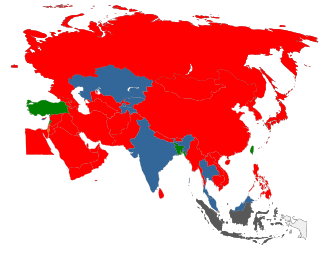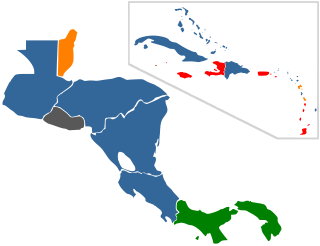Related Research Articles

A sex worker is a person who provides sex work, either on a regular or occasional basis. The term is used in reference to those who work in all areas of the sex industry.
Prostitution in Myanmar is illegal, but widespread. Prostitution is a major social issue that particularly affects women and children. UNAIDS estimate there to be 66,000 prostitutes in the country.
Prostitution in Turkey is legal and regulated. The secularization of Turkish society allowed prostitution to achieve legal status during the early 20th century. Known as "general houses" (genelevler) in the country, brothels must receive permits from the government to operate. In turn, the regulatory agencies issue identity cards to sex workers that give them rights to some free medical care and other social services. However, many local governments now have a policy of not issuing new registrations, and in some cities, such as Ankara and Bursa, brothels have been demolished by court order.
Prostitution in Senegal is legal and regulated. Senegal has the distinction of being one of the few countries in Africa to legalize prostitution, and the only one to legally regulate it. The only condition that it is done discreetly. Prostitution was first legalised in 1966. UNAIDS estimate that there are over 20,000 prostitutes in the country. The average age for a sex worker in Senegal is 28 years old and female.
Prostitution in Ecuador is legal and regulated, as long as the prostitute is over the age of 18, registered, and works from a licensed brothel. Prostitution is widespread throughout the country. Many brothels and prostitutes operate outside the regulatory system and the regulations have been less strictly enforced in recent years. 25,000 prostitutes were registered in the year 2000. In 2007 it was estimated that 70% of the prostitutes in the country were from Colombia. The country attracts Colombian prostitutes as the currency is the US$ rather than the unstable Colombian peso. UNAIDS estimate there to be 35,000 prostitutes in the country.
Prostitution in Hungary has been legalized and regulated by the government since 1999. Under the law, prostitutes are basically professionals who engage in sexual activities in exchange for money. The government allows this activity as long as they pay taxes and keep legal documents.

Sex workers' rights encompass a variety of aims being pursued globally by individuals and organizations that specifically involve the human, health, and labor rights of sex workers and their clients. The goals of these movements are diverse, but generally aim to legalize or decriminalize sex work, as well as to destigmatize it, regulate it and ensure fair treatment before legal and cultural forces on a local and international level for all persons in the sex industry.
Prostitution in Panama is legal and regulated. Prostitutes are required to register and carry identification cards. However, the majority of prostitutes are not registered. There are 2,650 sex workers registered with the government in 2008, but there was no accurate information regarding the total number of persons practising prostitution in the country. Some estimate put the number of unregistered prostitutes at 4,000.

Prostitution in Vietnam is illegal and considered a serious crime. Nonetheless, Vietnam's Ministry of Labour, Invalids and Social Affairs (MOLISA) has estimated that there were 71,936 prostitutes in the country in 2013. Other estimates puts the number at up to 200,000.
Prostitution in Kenya is widespread. The legal situation is complex. Although prostitution is not criminalised by National law, municipal by-laws may prohibit it.. It is illegal to profit from the prostitution of others, and to aid, abet, compel or incite prostitution.. UNAIDS estimate there to be 133,675 prostitutes in the country.
Prostitution in Indonesia is legally considered a "crime against decency/morality", although it is widely practiced, tolerated and even regulated in some areas. Some women are financially motivated to become prostitutes, while others may be forced by friends, relatives or strangers. Traditionally, they have met with customers in entertainment venues or special prostitution complexes, or lokalisasi (localization). However, recently internet forums and Facebook have been used to facilitate prostitute-client relations. In recent years, child sex tourism has become an issue at the resort islands of Batam and Bali.
Prostitution in Cyprus is not illegal, but operating brothels, organising prostitution rings, living off the profits of prostitution, encouraging prostitution or forcing a person to engage in prostitution are illegal activities.
Prostitution in Tunisia is regulated and confined to two small areas, one in Sfax and the other, Sidi Abdallah Guech in Tunis. Outside these two areas prostitution is illegal.

A sexually transmitted infection (STI), also referred to as a sexually transmitted disease (STD) and the older term venereal disease (VD), is an infection that is spread by sexual activity, especially vaginal intercourse, anal sex, oral sex, or sometimes manual sex. STIs often do not initially cause symptoms, which results in a risk of passing the infection on to others. Symptoms and signs of STIs may include vaginal discharge, penile discharge, ulcers on or around the genitals, and pelvic pain. Some STIs can cause infertility.
Prostitution in Namibia is legal and a highly prevalent common practice. Related activities such as solicitation, procuring and being involved in the running of a brothel are illegal. A World Bank study estimated there were about 11,000 prostitutes in Namibia.
Prostitution in Mongolia is illegal but widespread in some areas. The Global Fund for Tuberculosis, HIV/AIDS and Malaria estimated there were about 19,000 sex workers in the country in 2006. Many women in Mongolia turn to prostitution through poverty.

Prostitution in Laos is regarded as a criminal activity and can be subject to severe prosecution. It is much less common than in neighbouring Thailand. Soliciting for prostitution takes place mainly in the city's bars and clubs, although street prostitution also takes place. The visibility of prostitution in Laos belies the practice's illegality. As of 2016, UNAIDS estimates there to be 13,400 prostitutes in the country.
Prostitution in Togo is legal and commonplace. Related activities such as solicitation, living off the earnings of prostitution or procuring are prohibited. Punishment is up to 10 years imprisonment if minors or violence is involved.
Prostitution in Angola is illegal and prevalent since the 1990s. Prostitution increased further at the end of the civil war in 2001. Prohibition is not consistently enforced. Many women engage in prostitution due to poverty. It was estimated in 2013 that there were about 33,000 sex workers in the country. Many Namibian women enter the country illegally, often via the border municipality of Curoca, and travel to towns such as Ondjiva, Lubango and Luanda to work as prostitutes.

Legality of prostitution in the Americas varies by country. Most countries only legalized prostitution, with the act of exchanging money for sexual services legal. The level of enforcement varies by country. One country, the United States, is unique as legality of prostitution is not the responsibility of the federal government, but rather state, territorial, and federal district's responsibility.
References
- ↑ Bindel, Julie (2007-12-18). "Tourism built on abuse". The Guardian . London. Retrieved 2011-10-13.
- 1 2 Wright, Winthrop R (1990). Café con Leche: Race, Class, and National Image in Venezuela. Austin: University of Texas Press. p. 51.
- ↑ Friedman, Elisabeth J. (2000). Unfinished Transitions: Women and the Gendered Development of Democracy in Venezuela, 1936-1996. University Park, Pa: Pennsylvania State University Press. p. 156.
- ↑ Cabezas, Amalia Lucia (2000). "Legal Challenges to and by Sex Workers/Prostitutes". Cleveland State Law Review. 48: 87.
- 1 2 Raymond, Janice G, Jean d’Cunha, Siti Ruhaini Dzuhayatin, H Patricia Hynes, Zoraida Ramirez Rodriguez, and Aida Santos. (2002). "A Comparative Study of Women Trafficked in the Migration Process: Patterns, Profiles and Health Consequences of Sexual Exploitation in Five Countries (Indonesia, the Philippines, Thailand, Venezuela and the United States) ". North Amherst, MA: Ford Foundation, 161-162.
- ↑ Human Rights Bureau of Democracy, and Labor (2009). "2008 Country Reports on Human Rights Practices Venezuela". State.gov.
- 1 2 3 Camejo, María I, Gloria Mata, and Marcos Díaz. (2003). "Prevalencia De Hepatitis B, Hepatitis C Y Sífilis En Trabajadoras Sexuales De Venezuela." Revista de Saúde Pública 37: 339-44.
- 1 2 Martinez, Carlos, Michael Fox, and Jojo Farrell. (2010). Venezuela Speaks: Voices from the Grassroots. Oakland, Calif: PM Press, 102.
- 1 2 Ochoa, Marcia. (2008). "Perverse Citizenship: Divas, Marginality, and Participation in "Loca-Lization"." Women's Studies Quarterly 36, no. 3/4: 146-69.
- ↑ Vogel, Katrin. (2009) "The Mother, the Daughter, and the Cow: Venezuelan Transformistas’ Migration to Europe." Mobilities 4, no. 3 (2009/11/01): 367-87.
- 1 2 "Venezuela 2018 Trafficking in Persons Report". U.S. Department of State. Archived from the original on 1 August 2018. Retrieved 1 August 2018.